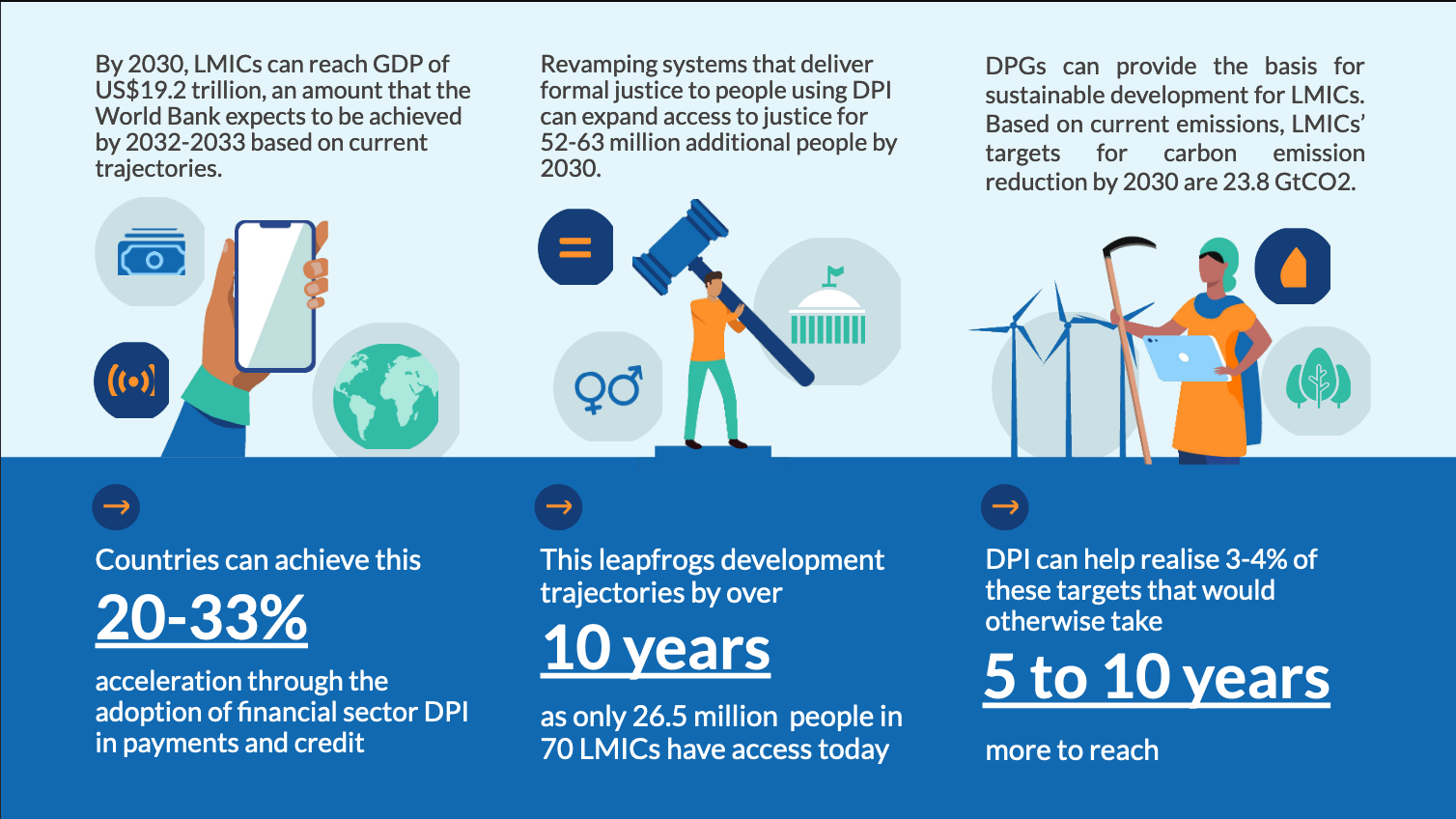Bold Investments for Digital Public Infrastructure: Quantifying the Human & Economic Impact

At the upcoming 77th Session of the UN General Assembly, world leaders alongside members of the private sector and civil society will convene on 21 September for a side-event titled: ‘The Future of Digital Cooperation: Building Resilience through Safe, Trusted, and Inclusive Digital Public Infrastructure’. The event will map out a bold, inclusive and innovative digital cooperation agenda to put the rights of people at the centre of digital public infrastructure, and garner the technological and financial contributions needed to move it forward. Save the date to join the event online.
An analysis of selected countries and sectors
The Digital Public Goods Alliance together with UNDP and Dalberg Advisors as consultants have undertaken a research project to estimate the economic and human impact for the implementation of digital public infrastructure (DPI) within finance, justice, and climate in 70 selected LMICs1. This is a short introduction to the main findings, with links to an executive summary and methodological note.
Update: The comprehensive report is now live, and available at this link.
This research project looked at DPI as an approach, regulation, and a technology-layer to create uniformity in which regularly-occurring digital tasks take place. Think of the standards and specifications required for carrying out instant digital money transactions, or how authentication works for national digital ID when opening a bank account, or renewing a driver’s license. These are three everyday examples of DPI. DPI lends uniformity in which such digital events take place, and provides open modules for others to create new applications and digital services in extension.
The report discusses sector-based DPI, which is a DPI-enabled end-to-end digital service or workflow for a specific sector. Sector-based DPI consists of context-specific verticals made up of digital public goods, open-source software, and in some cases proprietary solutions, which offer a cost-effective path for countries to adopt and adapt new technologies.
The focus on finance, justice, and climate sectors crafts a more precise analysis, and relied on available data, expert interviews, cases, and existing studies of digitalisation to bring forward the impact assessments.
Based on the preliminary findings we conclude that, across sectors, LMICs can leapfrog traditional development trajectories using DPG-based DPI (digital public infrastructure that uses open-source software solutions) to improve sector-specific and macro-level outcomes including improved service delivery, open innovation and accelerated implementation. Widespread adoption of such systems can – through inclusive, open, digitalisation – accelerate economic growth, increase access to justice, and support climate mitigation efforts.

Putting these numbers in context, it is evident that DPI within finance has immense potential to reach an enormous amount of people and unlock significant private sector innovation. This is the most mature sector with the strongest evidence from countries implementing DPI. In contrast, e-justice may be the least developed in terms of open-source digitalisation and therefore shows a high potential for improvement in public service delivery. Finally, within the climate sector, initiatives can often be capital intensive and therefore a DPI approach focused on reusability, global standards, and openness can be a cost-efficient way to support countries to meet their targets.
It is important to stress that the estimates in the illustration above and in the executive summary are conservative and only count for 70 selected LMICs. To ground the analysis, we have selected a handful of existing open-source products or digital public goods (DPGs) within each sector to anchor the benefits that the estimates rely upon in existing solutions. Methodologically, we have used a mix of case studies, interviews, available data, and studies to build econometric models to project the impact of wide-scale sectoral DPI implementation by 2030.
Looking ahead at the research agenda for the global open-source and digital public goods/infrastructure-community, this study shows that there is immense potential for expanded use of DPGs for DPI across sectors. It also shows that much work is yet to be done on documenting the impact of open, interoperable systems. Digital payments in particular and evidence from global digital health point towards the various benefits of sector-based DPI, but much more research could be done on this topic.
Finally, we hope you will engage with the executive summary that goes one level deeper on each sector and speaks to why we believe DPI can deliver this human and economic impact. Stay tuned for the full report we plan to release in the fall of 2022 that will include more detailed estimates and discuss qualitative benefits.
Save the date to join the ‘The Future of Digital Cooperation: Building Resilience through Safe, Trusted and Inclusive Digital Public Infrastructure’ UNGA77 side event on 21 September.